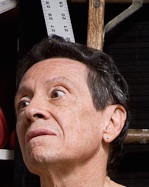 [Note: In February of 2010, the Russian ex-pat photographer Irene Caesar emailed to ask if I would participate in a project of hers titled “People of Art as Objects of Art,” which would involve posing for one or more portraits. I agreed. I’ve rarely turned down anyone’s request to photograph me, figuring that I’d learn something useful to me as a critic from any such encounter, whatever its outcome.
[Note: In February of 2010, the Russian ex-pat photographer Irene Caesar emailed to ask if I would participate in a project of hers titled “People of Art as Objects of Art,” which would involve posing for one or more portraits. I agreed. I’ve rarely turned down anyone’s request to photograph me, figuring that I’d learn something useful to me as a critic from any such encounter, whatever its outcome.
She also invited me to contribute an essay to a forthcoming monograph on her work, which I said I’d consider. I drafted the following account of our portrait session in April 2010, tweaked and polished it into this final version in 2011. But it didn’t seem suitable for inclusion in an artist’s own monograph, so I never submitted it to Caesar for her consideration or her publisher’s, simply putting it on the shelf. Re-reading it recently, with Easter (to which it pertains, if obliquely) almost upon us, I thought it merited publication here. Hence this premiere.
Click here for Caesar’s complete series, “People of Art as Objects of Art,” at her website. Click here for her video, “People of Art as Objects of Art,” at YouTube. In the Publications list at her website, Caesar refers to me as “the patriarch of photo criticism in the United States.” Hmmmmm … that’s very Russian Orthodox, making me sound like the head of something, whereas I’ve made it clear that I’m a Marxist of the Groucho deviationist tendency: I wouldn’t join any club that would have me as a member. — A. D. C.]
•
Irene Caesar Has Left the House:
A Perceptual Portrait
by A. D. Coleman
It is Easter Sunday, April 4, 2010, and Irene Caesar arrives an hour and a half late to make my portrait. The session supposed to start at 2 p.m. will now begin at 3:30, though she has assured me it will take only an hour.
My wife Anna will not return from her business trip to China for several weeks. Meanwhile, we have house guests who have occupied our upstairs rental unit for a week and will stay a few days longer. One of them, an old friend, is a Swedish-speaking Finn; the other, her life partner, is a Finn. Both from Helsinki, they have personal experience with a certain type of Russian woman emigré from St. Petersburg, which they immediately identify in Ms. Caesar. As a result, they observe her with immediate suspicion, expressing concern for my virtue when I explain that I plan to pose for her. We have a barbecue dinner in the rear garden planned for that evening, so I assure them that all will remain chaste and this visitor will be gone in plenty of time for our meal.
Caesar disregards them after the cursory introductions, apologizes quickly for her tardiness, then mulls her options over as I show her around our house on Staten Island. Parts of it, under renovation, have clutter and storage boxes stacked around; other areas show the finished result of how my wife and I reorder our living space. To my surprise, Caesar identifies three of the most disorganized and cramped spaces as ones where she wants to work — plus one quiet corner, with an antique oak rolltop desk and chair, where she says she’ll make a traditional portrait that I can use for publicity or other purposes.
Her theme, which she’s sketched out for me via email and phone conversations preceding her arrival, is “People of Art as Objects of Art” — which means using art-world figures such as Arthur Danto, Carter Ratcliff, Vitaly Komar, Alexander Melamid, and myself as models. She explains, in rapid-fire Russian-accented English, that the pictures will be “symbolic, conceptual, not typical, with Rembrandt lighting, a kind of picture no one has ever made before.”
In her car, now parked around the corner, she has brought a rolling cart with her studio lighting system, which she wheels in and begins to set up in one of the most crowded areas of the house, next to a floor-to-ceiling bookshelf just inside our front door. From various locations on the ground floor she selects and begins to arrange objects to decorate the corner: a child-size oak chair, a rectangular mirror whose silver is spotted and tarnished, a heavy wooden-framed antique mirror, my wife’s bright red plastic sandals, a yardstick, a long metal T-square used to measure and cut sheetrock. She props these up precariously around the chair, adjusting them this way and that. When she starts to set up her strobe I point her toward the most convenient outlet, then excuse myself, telling her to come find me when she has her set organized to her satisfaction.
Half an hour later, standing in my kitchen, she asks, “How do you feel about nudity?” Taking this as a question as to whether I’ll agree to pose in the buff, I tell her that I’m comfortable with my clothes off in front of the camera. In fact, it’s been some time since anyone photographed me naked; and, as I turned 66 in December 2009, I thought I’d find it instructive to see how my body looks in images, through someone else’s eyes, at this stage of my life.
Caesar tells me that she wants to evoke “the sensuality, even the eroticism, of the middle-aged man.” I’m not sure I’m a suitable stand-in for men my age, but I see no point in arguing with her about this. She wants something “passionate and personal,” she elaborates, not “cold in its sexuality like Ralph Gibson’s” erotic work. It’s been decades since Gibson explored that vein, and many others have done so since (Gilles Berquet, Tony Ward, Michael Rosen, Barbara Nitke, about all of whom I’ve written at length), so I’m surprised that she considers Gibson’s work in particular a reference point and feels such a need to contradict it in some way.
As it happens, I enjoy that work of Ralph’s (which I don’t find at all “cold”), but I decide to go along with whatever Caesar has in mind, though only up to a point. It’s now nearing 4:30, we’re almost an hour into the session, she has yet to make her first exposure, and it’s clear she has seriously underestimated the time this project will take.
Content at last with her setup in the foyer, Caesar has me undress and sit on the child-sized chair, makes some test shots to check her lighting, shows me the results. She maintains an incessant stream of talk — about what the pictures will mean, about the results she’s getting at the moment, and about how I need to adjust my posture, hand and leg and head positions, facial expression, the focus of my gaze.
Her strobe pops regularly. Every few minutes she bounces forward to show me the most recent exposure, exclaiming now and then over one or another she finds particularly satisfying, telling me how I need to turn my upraised left or right palm outward or inward a bit more, to move my eyes in one direction or another, to imagine myself at the moment of death with my soul leaving my body, “the deep sadness of dying” … in short, to express something that she evidently wants to convey in her images but isn’t necessarily anything that I feel, at least at the moment. “All that is very Russian, Irene,” I say to her at one point, but either she doesn’t hear me or she misses the funny part.
Meanwhile, as I try to find within myself something related to the mood she apparently wants me to project, what I feel mostly is anxiety. I’m naked, in a slightly chilly space, arms raised to hold my hands at a level with my face, one leg propped up on a box, surrounded by heavy objects made of wood, glass, and metal, all precariously perched in close proximity. And Caesar keeps telling me to change my position, shift this way and that, as the props creak, clatter against each other, sometimes slide and slip in potentially dangerous ways.
Caesar, engrossed in her process, seems entirely oblivious to my discomfort, even when, quietly, I give verbal indications thereof. Crouching, kneeling, sometimes squatting on a soft-sided suitcase of mine, she appears to have entered a trance state in which she channels the spirit of David Hemmings in Michelangelo Antonioni’s 1966 film Blow-Up. Squirming around to adjust her vantage point, she calls out, repeatedly, “Give it to me! Give to to me! Show me your eroticism!”
I do my level best to comply, but, not to my surprise, I’m a poor substitute for David Hemmings’s Veruschka in this situation. My eroticism doesn’t manifest itself in any way of which I’m aware. My sensuality — if we take this to mean my immediate sensory awareness — informs me that my body is becoming chilled and cramped, as a result of which my muscles have begun to tense, predictable consequences of maintaining the same unnatural pose for more than an hour in mildly perilous surroundings. As to my psychological state, I’m turning increasingly cranky, which fact escapes Caesar’s attention, though she has stated that her goal is “to bring a more intense psychological depth into photography as art.”
Eventually the inevitable happens: Caesar, lost in her viewfinder, not paying attention to the reality of the set she’s constructed, instructs me to alter my position in a certain way; in doing so I brush against something that leans against something else atop yet another artifact, and the house of cards collapses. I emerge, unscathed but nerves decidely on edge. The frame of the antique mirror has cracked. I declare the session over.
“But what about the other settings?” Caesar asks. “The kitchen, the professional portrait by the desk?” The session is finished, I repeat. She’d asked for an hour, I tell her, and I’ve given her the whole afternoon. It’s 6 p.m., I have guests, and dinner plans. We’re done. “No more?” she implores. It’s time to pack your gear, I say.
Reluctantly, she does so, while I get dressed and make a cup of coffee to warm myself up. I wonder if Rembrandt demanded as much of his models, and if they found him as much a pain in the ass. When Caesar has her lights and camera put away I escort her out to the front porch, give her driving directions back to the expressway, then say goodbye. She wheels her equipment trolley out our front gate, then turns back to me with a look of regret. “I’m greedy,” she says in parting. “What can I do?” It is the closest she comes to thanking me, or apologizing.
Inside again, I put the various artifacts she’d employed back where I had them stored before she came, tell my houseguests they can start the steaks. They’re clearly relieved that Caesar has departed; they’d been worried about me ever since she arrived. Half an hour later we’re drinking beer and eating our dinner on the patio under the terrace, following that up with schnapps. They interrogate me about the afternoon’s doings, pleased to hear that I haven’t broken my marriage vows nor even felt slightly tempted to do so, finding Caesar’s bizarre behavior “very Russian.” (I don’t know enough Russians to make such an assessment.) We laugh a lot, make assorted toasts with the schnapps, and the stresses of the afternoon dissolve.
•
A few days later Caesar emails me. She’s edited her shoot and posted her selections at her own website, and also at her Facebook page. I go online to see the results: two variant triptychs, one with the images full-frame and one with them cropped, both titled “Easter Sunday of A. D. Coleman.” To the extent that I can separate myself from my still-fresh memories of the experience of their production, they’re handsome, finely crafted images. (The lighting doesn’t strike me as particularly Rembrandtesque — much too even, little use of shadow for modeling.) I appear in reasonably good shape for a man my age, especially one who spends most of his time sitting at a desk working on a computer.
As for them being “symbolic, conceptual, not typical, a kind of picture no one has ever made before,” I really can’t say. I consider myself a lapsed Buddhist, raised by two left-wing atheists, one with an New York via eastern European Jewish background and the other from an Appalachian family of Scots Protestants, so I have absolutely no spiritual or emotional connection to Easter. Nor do mirrors and T-squares represent anything Christian, so far as I know. If they’re symbolic, that’s lost on me, along with their “conceptual” aspect.
As far as “passionate and personal” goes, not to mention “psychological depth,” these pictures may reflect Caesar’s passions and interior life, but they have nothing to do with mine. Whatever I manifested in my facial expressions and body language resulted from the combination of Caesar’s detailed posing of me and directorial instructions, my unschooled attempts to enact mental states she dictated, her personality and actions during those hours, and my efforts to keep my actual real-time physical and emotional experience from intruding on whatever she was up to during this encounter.
In short, I haven’t a clue what these pictures reveal about me, aside from demonstrating my willingness to participate in their making. Your guess is as good as mine, and perhaps better. As is typical for anyone who serves as the subject of a photograph, self-presentation before someone else’s lens makes critical distance in relation to the outcome hard to achieve. For much the same reason, I’ll recuse myself from any analysis of what they may tell us about Caesar as an artist and photographer; at least for the present, and perhaps permanently, I’m too close to the situation that generated them to see them objectively. For me, they serve simply as souvenirs of a strange encounter between myself and a woman with a camera. Let others read out from them (or into them) whatever they choose.
•
 Special offer: If you want me to either continue pursuing a particular subject or give you a break and (for one post) write on a topic — my choice — other than the current main story, make a donation of $50 via the PayPal widget below, indicating your preference in a note accompanying your donation. I’ll credit you as that new post’s sponsor, and link to a website of your choosing. Include a note with your snail-mail address (or email it to me separately) for a free signed copy of my 1995 book Critical Focus!
Special offer: If you want me to either continue pursuing a particular subject or give you a break and (for one post) write on a topic — my choice — other than the current main story, make a donation of $50 via the PayPal widget below, indicating your preference in a note accompanying your donation. I’ll credit you as that new post’s sponsor, and link to a website of your choosing. Include a note with your snail-mail address (or email it to me separately) for a free signed copy of my 1995 book Critical Focus!


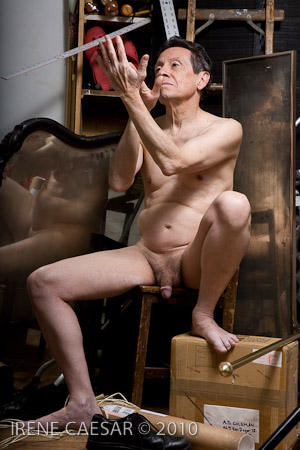
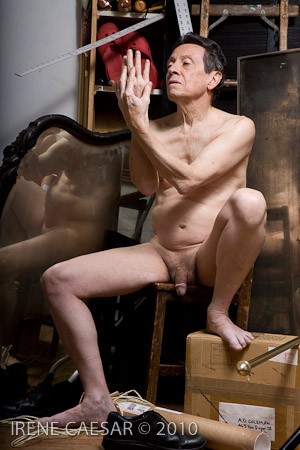
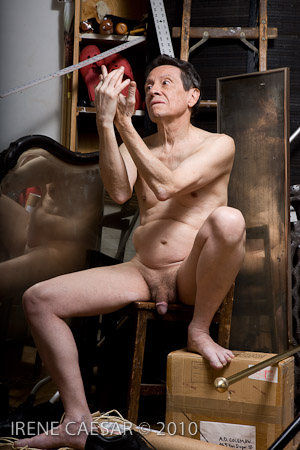
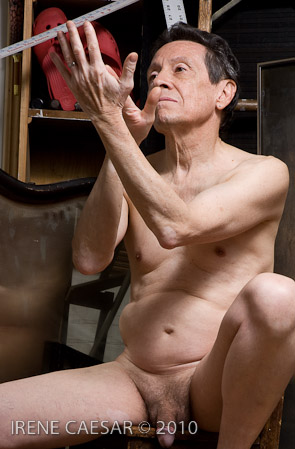
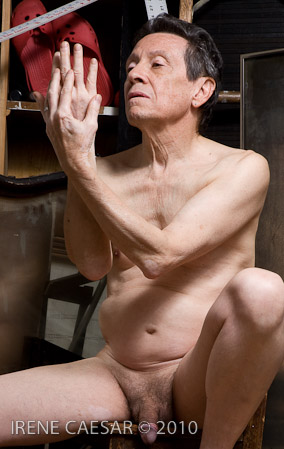
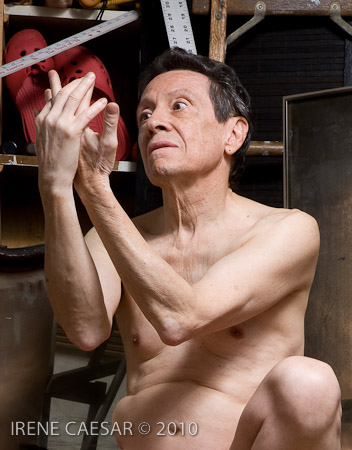




Allan,
I love this story of your encounter with Irene Caesar! One of the things I most love about your writing is its inherent sense of humor and irony, hard qualities to find in these dire times and, I will say a bit self-congratulatorily (?), somewhat similar to my own. I’ve been reading this while having Easter breakfast at the diner around the corner from my SF apartment, laughing out loud several times.
Among the issues this piece stirs up in me is the difference between a shoot in which the models are clay from which the photographer crafts images in his/her head, and a shoot in which the photographer tries to say something about the subject, albeit not without inevitable bias and interpretation. Perhaps the two are not mutually exclusive. All of which takes me back to the issue of exploitation of one’s subjects …
Meanwhile, Happy Easter from one atheist Jew to another. A propos of nothing, my beloved uncle’s jingle for this day was: “Spring is sprung, the Lord is ris, I wonder where the birdies is.” I hope spring is springing and resurrecting for you.
take care,
David
I visited Ms. Caesar’s website. Lots of naked people doing silly things in clumsy set ups. Pretentious, unsophisticated, comic by accident, and ultimately pointless.
Ms. Caesar’s statement is a textbook sample of narcissism. Count the number of “I”s, and amusing assertions of earth-shaking innovation like nothing ever seen by humankind before. (Kind of reminded me of a certain presidential candidate.) And though Russian artist Vitaly Komar and well known patron of the Russian artists ex-pat community, Norton Dodge (who supported City Without Walls’ show of Russian dissident art) posed for this photographer and whose portraits are the most conventional and respectful, the underlying theme seems to be to get accomplished people get naked, vulnerable and messy in front of the lens.
Your Finnish guests had good reason to be concerned. Incidentally, cropped head shots of you are titled “St. Sebastian”. I guess that’s what she was going for. Lucky you weren’t impaled. 🙂
Last laugh of the day, good for you.
you are a really good sport, Allen. and yes, you are aging fine. i find it quite scary to look at these images and reflect on being nude and in the hands of a photographer who doesn’t collaborate.
this kind of unhinges me; there is a brutal tenderness—whose narrative is this? i am thinking about the combination of your text, her photos and somewhere in the back of my head from decades ago is that text you wrote on the directorial photo. would this i wonder be useful to students. or would it make them queasy, like i am.
warmly
Sandra
All the subjects of this series of Caesar’s images are consenting adults, who could have called a halt to the proceedings at any point. I could have refused to participate, or called a halt to the session at any point. So, in that sense, I’m complicit in the whole shebang and have to consider it, in that sense, a collaboration.
And I’m not unhappy with the outcome. I don’t find the images embarrassing in any way; they’re certainly well-crafted; and, as I noted, I’m pleased to have them as a record of how I looked at that age.
As to what meaning one might ascribe to them beyond their recordative function … I have to leave this to the viewer. That aspect of the imagery involved no collaboration.
Certainly Caesar’s approach here was directorial, to use the term I coined in 1976. That essay of mine has been regularly quoted and cited, widely anthologized, and frequently assigned in college courses. So I think students come across it often.
This morning I burst out laughing at Caesar’s exhortation to “Give it to me! Give to to me! Show me your eroticism!” Allan, this column is pure comedy gold.